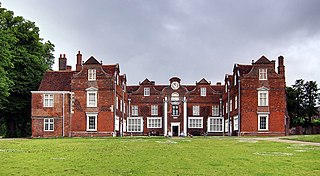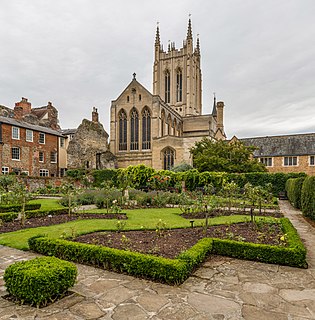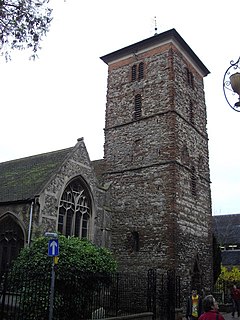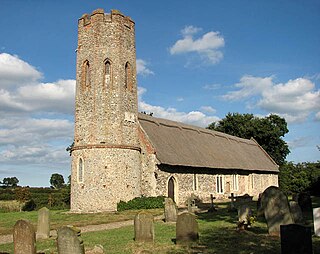
Ipswich is a historic county town in Suffolk, England. The town is located in East Anglia about 10 miles (16 km) away from the mouth of the River Orwell and the North Sea. Ipswich is both on the Great Eastern Main Line railway and the A12 road, it is 66 miles (106 km) north-east of London, 54 miles (89 km) east-southeast of Cambridge, and 45 miles (72 km) south of Norwich. Ipswich is surrounded by two Areas of Outstanding Natural Beauty (AONB); Suffolk Coast and Heaths and Dedham Vale.

A wool church is an English church financed primarily by donations from rich merchants and farmers who had benefitted from the medieval wool trade, hoping to ensure a place in heaven due to their largesse.

All Saints and St Nicholas, South Elmham is a civil parish in the north of the English county of Suffolk. It is 5 miles (8.0 km) south of the market town of Bungay and the same distance north-west of Halesworth and east of Harleston. The parish is in the East Suffolk district and is one of the parishes that make up the area around Bungay known as The Saints. It includes the settlements of All Saints, South Elmham and St Nicholas, South Elmham.

Blundeston is a village and civil parish in the north of the English county of Suffolk. It is 3.5 miles (5.6 km) north-west of Lowestoft, 6 miles (9.7 km) south of Great Yarmouth and around 1.75 miles (2.82 km) inland from the North Sea coast. It is part of the area known as Lothingland in the East Suffolk district. Blundeston Prison was located on the southern edge of the village but closed in early 2014.

St Edmundsbury Cathedral is the cathedral for the Church of England's Diocese of St Edmundsbury and Ipswich. It is the seat of the Bishop of St Edmundsbury and Ipswich and is in Bury St Edmunds in Suffolk. Originating in the 11th century, it was rebuilt in the 12th and 16th centuries as a parish church and became a cathedral in 1914; it has been considerably enlarged in recent decades.

Grundisburgh is a village of 1,584 residents situated in the English county of Suffolk. It is in the East Suffolk district, six miles north-east from Ipswich and four miles north-west of Woodbridge located on the B1079. Flowing through the village are the rivers Lark and Gull. The finding of Ipswich and Thetford-type pottery suggests that there was settlement in the Middle Saxon era. The village is recorded in the Domesday Book as "Grundesbur", "Grundesburg", "Grundesburh" or "Grundesburc". Grundisburgh is pronounced "Gruns-bruh".

All Saints' South Elmham is a village and former civil parish in the north of the English county of Suffolk. The parish was combined with St Nicholas South Elmham in 1737 to form the parish of All Saints and St. Nicholas, South Elmham. It is 5 miles (8.0 km) south of the market town of Bungay in the East Suffolk district. It is one of the villages that make up the area around Bungay known as The Saints.

Colchester in Essex, England, has a number of notable churches.

The Church of St John of Beverley, Whatton is a parish church in the Church of England in Whatton-in-the-Vale, Nottinghamshire, dedicated to St John of Beverley. The church is Grade II* listed by the Department for Digital, Culture, Media and Sport.

Ashby is a former civil parish in the north of the English county of Suffolk. It is 5 1⁄2 miles (8.9 km) nort-west of Lowestoft in the East Suffolk district. The parish was combined with Somerleyton and Herringfleet to form the combined parish of Somerleyton, Ashby and Herringfleet in 1987.

St Lawrence Church is a grade 2* listed church in Ipswich, Suffolk, that is now used as a community centre. The 15th-century church has the oldest ring of five church bells in the world.

St Andrew's Church is a redundant Church of England parish church in the village of Wroxeter, Shropshire, England. It is recorded in the National Heritage List for England as a designated Grade I listed building, and is under the care of the Churches Conservation Trust. Both the village of Wroxeter and the church are in the southwest corner of the former Roman town of Viroconium.

St John the Baptist's Church is a redundant Anglican church in the village of Strensham, Worcestershire, England. It is recorded in the National Heritage List for England as a designated Grade I listed building, and is under the care of the Churches Conservation Trust. Clifton-Taylor includes the church in his list of 'best' English parish churches.

All Saints Church is an active Anglican church in the centre of the town of Evesham, Worcestershire, England. All Saints and its neighbour St Lawrence's Church were built by the Benedictine monks of Evesham Abbey in the 12th century to serve the people of Evesham. All Saints is now the town's parish church, as St Lawrence's was declared redundant in the 1970s.

St Mary's Church is a historic Anglican church in the hamlet of Akenham, Suffolk, England. It is recorded in the National Heritage List for England as a designated Grade II* listed building, and is under the care of The Churches Conservation Trust. It stands in an isolated position in fields 3 miles (5 km) north of Ipswich.

St Mary at the Quay Church is a redundant Anglican church in Ipswich, Suffolk, England. It is recorded in the National Heritage List for England as a designated Grade II* listed building, and is under the care of the Churches Conservation Trust. It originally served the thriving industry around the docks. The area then became run down but has more recently been redeveloped, with the dock being converted into a marina.

St Clement’s Church, Norwich is a Grade I listed redundant parish church in the Church of England in Norwich. It is dedicated to St Clement, a popular Danish saint and patron of seafarers.

The Church of St Giles is a Grade II*-listed church in Cambridge, England. It is a Church of England parish church in the Parish of the Ascension of the Diocese of Ely, located on the junction of Castle Street and Chesterton Road. It was completed and consecrated by the Bishop of Ely in 1875, to replace an earlier church founded in 1092. The church, which added "with St Peter" to its appellation when the neighbouring St Peter's Church became redundant, is home to both an Anglican and a Romanian Orthodox congregation and is used as a venue for concerts and other events. It also serves as a main location of the Cambridge Churches Homeless Project.
Dr. John Marcus Blatchly MBE FSA was a schoolmaster, author and noted historian of the county of Suffolk.



















